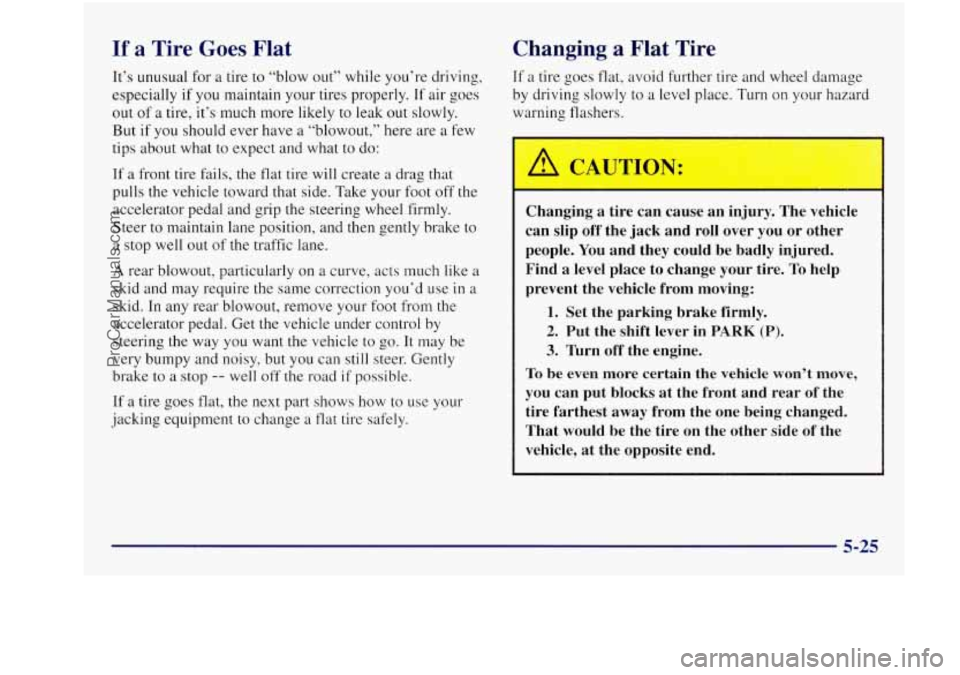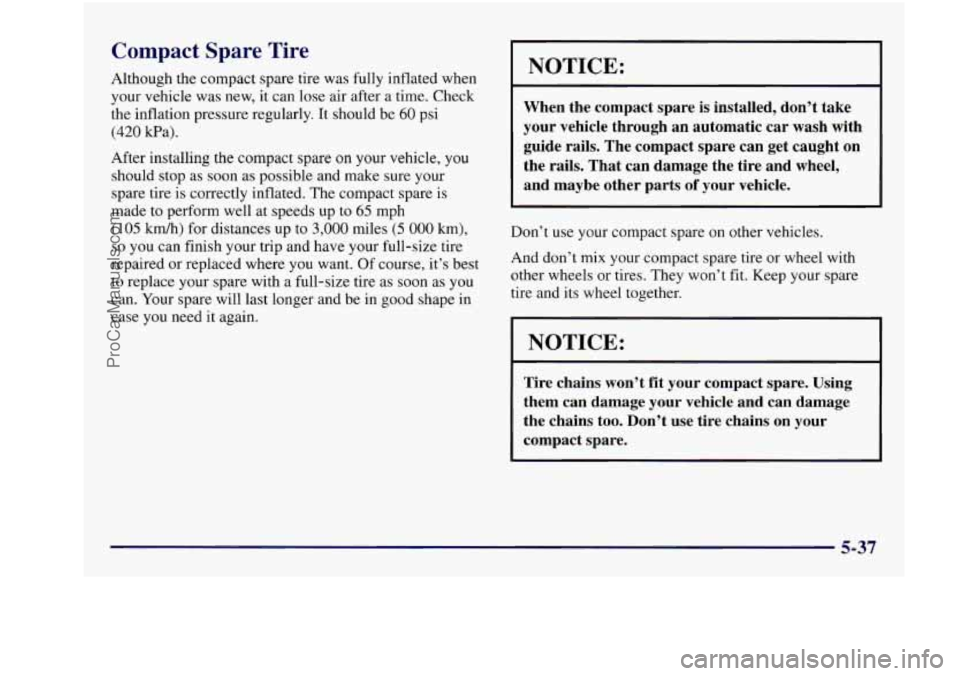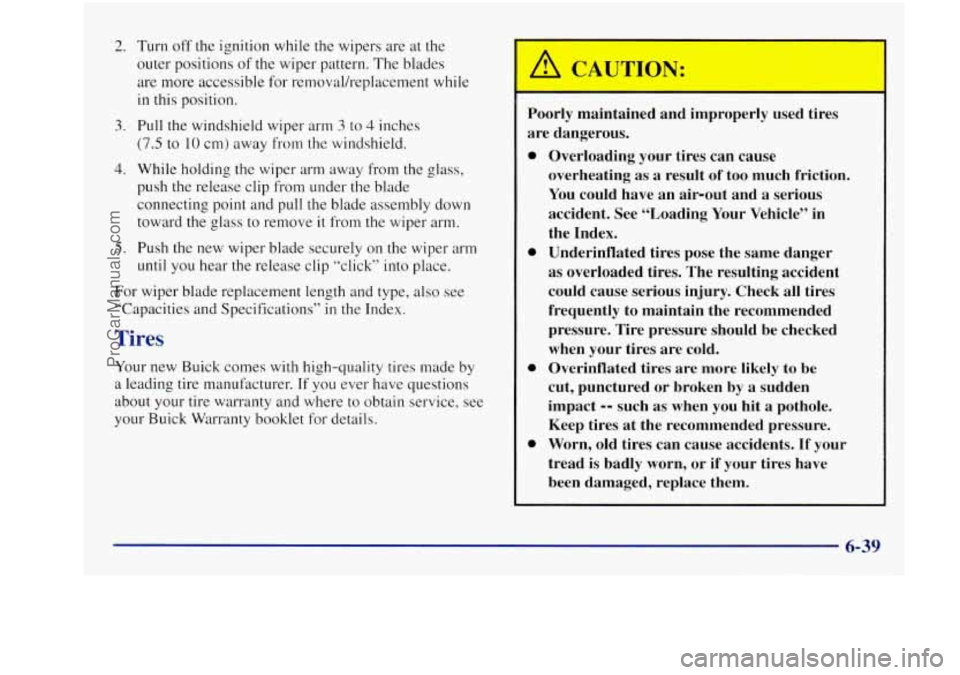Page 261 of 422

If a Tire Goes Flat
It’s unusual for a tire to “blow out” while you’re driving,
especially
if you maintain your tires properly. If air goes
out of a tire, it’s much more likely to leak out slowly.
But if you should ever have a “blowout,’’ here are
a few
tips about what to expect and what to do:
If a front tire fails, the flat tire will create a drag that
pulls the vehicle toward that side. Take your foot off the
accelerator pedal and grip the steering wheel firmly.
Steer to maintain lane position, and then gently brake to
a stop well out
of the traffic lane.
A rear blowout, particularly on a curve, acts much like a
skid and may require the same correction you’d use
in a
skid. In any rear blowout, remove your foot from the
accelerator pedal. Get the vehicle under control by
steering the way you want the vehicle to go. It may be
very bumpy and noisy, but you can still steer. Gently
brake
to a stop -- well off the road if possible.
If
a tire goes flat, the next part shows how to use your
jacking equipment to change
a flat tire safely.
Changing a Flat Tire
If a tire goes flat, avoid further tire and wheel damage
by driving slowly to a level place. Turn on your hazard
warning flashers.
I
Changing a tire can cause an injury. The vehicle
can slip off the jack and roll over you or other
people. You and they could be badly injured.
Find
a level place to change your tire. To help
prevent the vehicle from moving:
1. Set the parking brake firmly.
2. Put the shift lever in PARK (P).
3. Turn off the engine.
To be even more certain the vehicle won’t move,
you can put blocks at the front and rear
of the
tire farthest
away from the one being changed.
That would be the tire on the other side of the
vehicle,
at the opposite end.
ProCarManuals.com
Page 265 of 422
If your vehicle is equipped
with wheel covers, be sure
to use a wheel wrench to
begin the process
of
loosening the plastic wheel
nut caps.
They won’t come off.
You will only be able to loosen
them. Once
you have loosened the plastic nut caps with
the wheel wrench, if needed, you can finish loosening
them with your fingers.
Then, using the flat end
of the wheel wrench, pry along
the edge
of the wheel cover until it comes off. Be
careful; the edge may be sharp. Don’t try to remove the
cover with your bare hands.
Removing the Flat Tire and Installing the
Spare
Tire
I. Using the wheel wrench, loosen all the wheel nuts.
Don’t remove them yet.
head a few inches.
2. Turn the jack handle to the right to raise the jack lift
5-29
-
ProCarManuals.com
Page 267 of 422
A CAUTION:
I
Raising your vehicle with the jack improperly
positioned can damage the vehicle and even
make the vehicle fall.
To help avoid personal
injury and vehicle damage, be sure to fit the jack
lift head into the proper location before raising
the vehicle.
4. Raise the vehicle by turning the jack handle to the
right. Raise the vehicle far enough
off the ground for
the spare tire to fit under the vehicle.
5. Remove all wheel nuts and take off the flat tire.
5-31
-
ProCarManuals.com
Page 270 of 422
-
Incorrect wheel nuts or improperly tightened
wheel nuts can cause the wheel to become loose
and even come
off. This could lead to an accident.
Be sure to use the correct wheel nuts.
If you have
to replace them, be sure to get new GM original
equipment wheel nuts.
Stop somewhere
as soon as you can and have the
nuts tightened with
a torque wrench to 100 lb-ft
(140 Nom).
5-34
I NOTICE:
Improperly tightened wheel nuts can lead to
brake pulsation and rotor damage. To avoid
expensive brake repairs, evenly tighten the wheel
nuts in the proper sequence and to the proper
torque specification.
Don’t try to put the wheel cover on your compact spare
tire. It won’t fit. Store the wheel cover
in the trunk until
you have the flat tire repaired or replaced.
NOTICE:
Wheel covers won’t fit on your compact spare. If
you try to put a wheel cover on your compact
spare, you could damage the cover or the spare.
ProCarManuals.com
Page 271 of 422
Storing the Flat Tire and Tools
Stc ng a jack, a tire or other equipment in the
passenger compartment
of the vehicle could
cause injury. In a sudden stop or collision, loose
equipment could strike someone. Store all these
in the proper place.
After you’ve put the compact spare tire on your vehicle,
you’ll need to store the flat tire
in your trunk. Use the
following procedure to secure the flat tire in the trunk.
When storing a full-size tire
you must use the extension
with the protector/guide to help avoid wheel surface
damage. Use
the extension and protector/guide located
in the foam holder.
To store a full-size tire, place the tire
valve stem facing down and then remove the
protector/guide and attach the retainer securely. When reinstalling
a compact spare tire, put the
protector/guide back in the foam holder. Store the cover
as far forward as possible.
5-35
ProCarManuals.com
Page 273 of 422

Compact Spare Tire
Although the compact spare tire was fully inflated when
your vehicle was new, it can lose air after a time. Check
the inflation pressure regularly. It should be
60 psi
(420 kPa).
After installing the compact spare
on your vehicle, you
should stop as soon as possible and make sure your
spare tire is correctly inflated. The compact spare is
made to perform well at speeds up to
65 mph
(105 kmh) for distances up to 3,000 miles (5 000 km),
so you can finish your trip and have your full-size tire
repaired or replaced where
you want. Of course, it’s best
to replace your spare with a full-size tire as soon as you
can. Your spare will last longer and be in good shape in
case you need it again.
NOTICE:
When the compact spare is installed, don’t take
your vehicle through an automatic car wash with
guide rails. The compact spare can get caught
on
the rails. That can damage the tire and wheel,
and maybe other parts
of your vehicle.
Don’t use your compact spare on other vehicles.
And don’t
mix your compact spare tire or wheel with
other wheels or tires. They won’t fit. Keep your spare
tire and its wheel together.
NOTICE:
Tire chains won’t fit your compact spare. Using
them can damage your vehicle and can damage
the chains too. Don’t use tire chains on your
compact spare.
ProCarManuals.com
Page 315 of 422

2.
3.
4.
5.
Turn off the ignition while the wipers are at the
outer positions of the wiper pattern. The blades
are more accessible for removal/replacement while
in this position.
Pull the windshield wiper
arm 3 to 4 inches
(7.5 to 10 cm) away from the windshield.
While holding the wiper arm away from the glass,
push
the release clip from under the blade
connecting point and pull the blade assembly down
toward the glass to remove
it from the wiper arm.
Push the new wiper blade securely on the wiper arm
until
you hear the release clip “click” into place.
For wiper blade replacement length and type,
also see
“Capacities and Specifications”
in the Index.
Tires
Your new Buick comes with high-quality tires made by
a leading tire manufacturer. If you ever have questions
about your tire warranty and where to obtain service, see
your Buick Warranty booklet for details. Poorly maintained and improperly used tires
are dangerous.
0
Overloading your tires can cause
overheating as
a result of too much friction.
You could have an air-out and a serious
accident. See “Loading Your Vehicle” in
the Index.
Underinflated tires pose the same danger
as overloaded tires. The resulting accident
could cause serious injury. Check all tires
frequently to maintain the recommended
pressure. Tire pressure should be checked
when your tires are cold. Overinflated tires are more likely
to be
cut, punctured or broken by a sudden
impact
-- such as when you hit a pothole.
Keep tires at the recommended pressure.
Worn, old tires can cause accidents.
If your
tread is badly worn, or if your tires have
been damaged, replace them.
6-39
ProCarManuals.com
Page 316 of 422
Inflation -- Tire sure
The Tire-Loading Information label, which is on the
driver’s
door edge, above the door latch, shows the
correct inflation pressures for your tires when they’re
cold.
“Cold” means your vehicle has been sitting for at
least three
hours or driven no more than 1 mile (1.6 km).
-
NOTICE:
Don’t let anyone tell you that underinflation or
overinflation is all right. It’s not.
If your tires
don’t have enough air (underinflation), you can
get the following:
0 Too much flexing
0 Too much heat
0 Tire overloading
Bad wear
0 Bad handling
0 Bad fuel economy.
NOTICE: (Continued) NOTICE: (Continued)
If your tires have too much air (overinflation),
you can get the following:
0 Unusual wear
Bad handling
0 Rough ride
0 Needless damage from road hazards.
When to Check
Check your tires once a month or more.
Don’t forget your compact spare tire. It should be
at 60
psi (420 kPa).
6-40
ProCarManuals.com